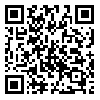Sun, Dec 7, 2025
[Archive]
Volume 18, Issue 3 (September 2022)
IJEEE 2022, 18(3): 73-84 |
Back to browse issues page
Download citation:
BibTeX | RIS | EndNote | Medlars | ProCite | Reference Manager | RefWorks
Send citation to:



BibTeX | RIS | EndNote | Medlars | ProCite | Reference Manager | RefWorks
Send citation to:
Khandar-Shahabad G, Beiza J, Pouladi J, Abedinzadeh T. A New Regionalization Scheme for Wide-Area Backup Protection of Power Network. IJEEE 2022; 18 (3) :73-84
URL: http://ijeee.iust.ac.ir/article-1-2366-en.html
URL: http://ijeee.iust.ac.ir/article-1-2366-en.html
Abstract: (3249 Views)
A new regionalization algorithm is presented to improve wide-area backup protection (WABP) of the power system. This method divides the power system into several protection zones based on the proposed optimal measurement device (MD) placement and electrical distances. The modified binary particle swarm optimization is used to achieve the optimal MD placement in the first step. Next, the power system is divided into small protection zones (SPZ) using the topology matrix of the power system and MD locations. Finally, the SPZs are combined to accomplish the main protection zones and protection centers according to electrical distances, degree of buses, and communication link constraints. The introduced regionalization formulation can help provide a rapid and secure WABP for power systems. This method was applied to several IEEE standard test systems, and the simulation results demonstrated the effectiveness of the proposed scheme.
Keywords: Communication Constraints , Electrical Distance , MD Placement , Power System Regionalization , Protection Zone , Wide-Area Backup Protection
Full-Text [PDF 836 kb]
(1041 Downloads)
- A new MDs placement is presented for wide-area protection of the power system. This method results in minimum MDs numbers compared with other methods for different standard test systems.
- The network topology matrix, electrical distances, and communication constraints are considered in the proposed algorithm. Therefore, the optimal protection zones are obtainable for different power systems.
- The proposed scheme ensures secure and fast wide-area backup protection.
Type of Study: Research Paper |
Subject:
Fault Location
Received: 2021/12/07 | Revised: 2024/05/13 | Accepted: 2022/08/06
Received: 2021/12/07 | Revised: 2024/05/13 | Accepted: 2022/08/06
| Rights and permissions | |
 |
This work is licensed under a Creative Commons Attribution-NonCommercial 4.0 International License. |









